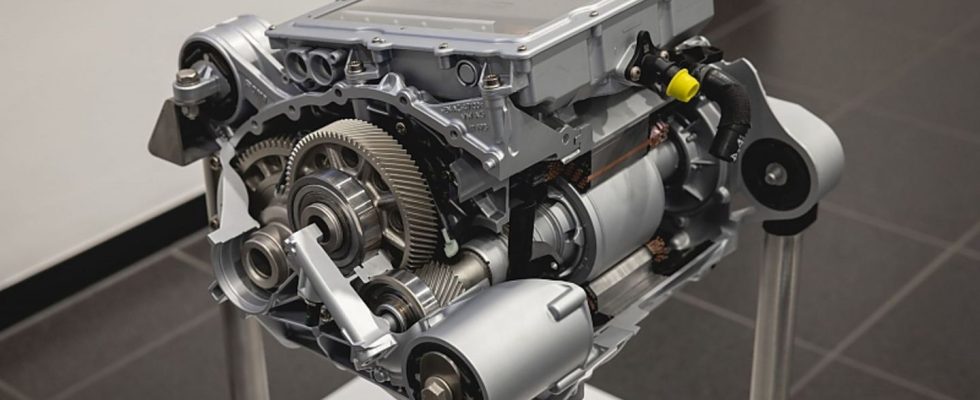Technology: Porsche Macan E 2024
Look for differences
PPE electric motor front (Porsche)
© press-inform – the press office
Porsche is getting the Macan E on track. The Zuffenhausen Stromer shares the technology of the Premium Electric platform with the Audi Q6 e-tron. In order to differentiate themselves, the Stuttgart-based company offers a few technical details.
This should also work with the Q6 e-tron and Macan. Especially since Porsche will serve both ends of the automotive food chain with the entry-level and top versions of the Macan at the market launch in the second half of 2024. The power variant will have a system output of around 450 kW / 612 hp and a torque of over 1,000 Newton meters. This version is worth taking a closer look at. In contrast to the entry-level version, this Macan is equipped with the performance rear end, which is initially only available from Porsche. As the people of Zuffenhausen emphasize. Whether an Audi Q6 e-tron RS will also use this component remains to be seen. Thanks to this design in combination with the very compact electric motors, Porsche technicians were able to install rear-axle steering on a Macan for the first time, which turns the wheels at a maximum of five degrees. The all-wheel drive goes well with this, in which the rear axle is in command and the front axle is only switched on when necessary. The top-of-the-range Macan E is exclusive to the controlled transverse lock in the differential, and the Zuffenhausen engineers have also invested a lot of development work in the front axle steering.
In the Top Macan with Preformance rear end, the rear axle motor is not only larger than in the basic version (230 millimeters in diameter, active length 210 millimeters in contrast to 210 millimeters and 200 millimeters in the entry-level version), but is also rotated horizontally by 180 degrees. This means that the heavy elements are at the back and ensure a rear-heavy axle load distribution of 48 (front) to 52. At the front, both models have a smaller PSM (permanently excited synchronous electric machines) with a diameter of 210 millimeters and a length of 100 millimeters. The electric machines are PSM because, although they are a little more expensive, they can be regulated more quickly and are so thermally stable that they enable high continuous performance. The pulse inverter also contributes to this, as silicon carbide (SiC) is used on the rear axle instead of silicon (front axle). This increases efficiency and performance. “There has been a major development step in power electronics”; summarizes Porsche Macan Powertrain Manager Antoon Janssen. The recuperation performance of a maximum of 240 kW is also quite decent. This corresponds to a delay of around 4.3 m/s².
When it comes to the battery with a capacity of 100 kilowatt hours, the cards are again clearly mixed for uniformity. Which is no harm with the 800 volt technology, which has already helped Porsche achieve fast charging times with the Taycan. The battery consists of twelve modules with prismatic cells; in which the cobalt content was reduced by around 60 percent. The battery is designed so that each module, including the cell module controller, is replaceable. The control unit can even be accessed from the interior and can therefore be changed.
Charging does not suffer as a result: at peak power, 270 kW of electricity should flow into the batteries. But when it comes to charging, it’s not the maximum speed that counts, but rather the plateau, i.e. the consistency with which the electricity flows into the energy storage as quickly as possible. The Zuffenhausen-based company promises fast charging times due to the conditioning of the battery, which begins up to 30 minutes before recharging. Among other things, a six-kilowatt high-voltage heater is intended to ensure that the cells are at the right temperature during the cold season. In less than 22 minutes, the battery charge level should increase from ten to 80 percent. On a DC fast charger!
Things look different with alternating current. When the Macan is connected to an AC charging station, a maximum of 11 kW of electricity flows into the battery. You can definitely expect 22 kW from a premium electric car, especially since not everyone has their own wallbox and a blocking fee often applies after four hours of charging. A full charge time of nine to ten hours isn’t exactly useful. It doesn’t help that the Integrated Power Box (IPB) with the onboard AC charger, the high-voltage heater and the DC/DC converter combines three components compactly in one unit.
When it comes to infotainment, Porsche benefits from the group’s unity, as the Macan E will for the first time have a head-up display with augmented reality that projects an 87-inch area ten meters away in front of the car. Since 85 percent of Porsche drivers use an iPhone, Apple CarPlay is mandatory, even though the software is based on Android Automotive and Google Maps will soon also be displayed in the instrument cluster. Porsche developed the voice assistant with 23 languages (including six new ones) itself and now the front passenger can also get their due when entertaining with the infotainment, as seat-based voice recognition is possible. The new openness of the Zuffenhausen entertainment industry also includes the fact that third-party apps such as Spotify provide entertainment.

